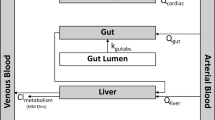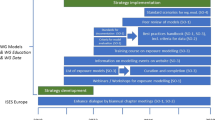Abstract
We are at the dawn of a new era of quantitative consumer exposure and risk assessment of chemicals driven by regulatory mandates. This remarkable development also signals the beginning of a dramatic resurgence in the need for and development of human exposure models. This paper presents some of the philosophical background underlying exposure modeling in the context of human health risk assessment. The basic types of and structure of inhalation exposure models are discussed, as well as the research needed to move us forward into this exciting new period of development.
This is a preview of subscription content, access via your institution
Access options
Subscribe to this journal
Receive 6 print issues and online access
$259.00 per year
only $43.17 per issue
Buy this article
- Purchase on Springer Link
- Instant access to full article PDF
Prices may be subject to local taxes which are calculated during checkout
Similar content being viewed by others
References
Brief R.S. A simple way to determine air contaminants. Air Eng 1960: 2: 39–41.
Carslaw H.S., and Jaeger J.C. Conduction of Heat in Solids, 2nd edn. Oxford University Press, London, 1959, pp. 260–261.
Fehrenbacher M.C., and Hummel A.A. Evaluation of the mass balance model used by the Environmental Protection Agency for estimating inhalation exposure to new chemical substances. Am Ind Hyg Assoc J 1996: 57: 526–536.
Haas H.B., and Newton R.F. Correction of boiling points to standard pressure. In: Weast RC (ed) CRC Handbook of Chemistry and Physics, 59th edn. CRC Press, Boca Raton, FL, 1978, p. D-228.
Jayjock M.A. Modeling Inhalation Exposure. Chapter 8 In: The Occupational Environment – Its Evaluation and Control. Chap. 8. American Industrial Hygiene Association: Fairfax, VA, 2003.
Jayjock M.A., Price P.S., Chaisson C.F., Mathis E.T., and Tedder D.R., “Evaluation of the Capabilities of PROMISE©, ConsExpo and MCCEM Exposure Models for Conducting Consumer and Institutional Scenario-Based Exposure Assessments”, presented at Global Net on “CONSUMER EXPOSURE MODELLING” Workshop on Consumer Model Inter-comparison (Phase I) 26–27 October 2004, Ispra, Italy (Commission of the European Communities — Joint Research Centre, Institute for Health and Consumer Protection.
Jayjock M.A., Chaisson C.F., Franklin C.A., and Price P.S., Using publicly available information to create exposure and risk-based ranking of chemicals used in the workplace and consumer products (in draft) 2007.
JRC. Source Characterization and Transport and Fate Source, 20 and 21 June 2005, workshop proceedings. European Commission – Joint Research Centre, Institute for Health and Consumer Protection Physical and Chemical Exposure Unit in Intra (Italy) Available at http://www.jrc.ec.europa.eu/pce/documentation/eur_reports/Global%20CEM%20Net%20Workshop%202%20SOURCES.pdf.Accessed 12 February 2007.
Keil C.B. Eddy diffusivity modeling. In: Keil K.B. (Ed.). Mathematical Models for Estimating Occupational Exposure to Chemicals. American Industrial Hygiene Press, Fairfax, VA, 2000.
Lyman W.J., Reehl W.F., and Rosenblat D.H. Handbook of chemical property estimation methods, Chapters 11, 14 and 15. McGraw Hill, New York, 1982.
Mulhausen J.R. “Interpreting Monitoring Data: Are We Making the Right Judgments ?”, presented at the Professional Conference of Industrial Hygiene. Denver, CO, 2005.
Mulhausen J.R. “Exposure Judgments: Continuously Improving Accuracy Using the AIHA Strategy with its Exposure Control Banding Approach”, in Roundtable RT 233 at the AIHCE, Chicago, 2006.
Price P.S., Young J.S., and Chaisson C.F. Assessing aggregate and cumulative pesticide risks using a Probabilistic Model. Ann Occup Hyg 2001: 45 (1001): S131–S142.
Roach S.A. On the role of turbulent diffusion in ventilation. Ann Occup Hyg 1981: 24 (1): 105–132.
Scheff P.A., Friedman R.L., Franke J.E., Conroy L.M., and Wadden R.A. Source activity modeling of Freon emissions from open-top vapor degreasers. Appl Occup Environ Hyg 1992: 7: 127–134.
Sparks L.E., Tichenor B.A., Chang J., and Guo Z. Gas-Phase Mass Transfer Model for predicting volatile organic compound (VOC) emission rates from indoor pollutant sources. Indoor Air 1996: 6 (1): 31.
Tichenor B.A., Guo Z., Dunn J.E., Sparks L.E., and Mason M.A. The interaction of vapor phase organic compounds with indoor sinks. Indoor Air 1991: 1: 1–23.
US Environmental Protection Agency “A Manual for the Preparation of engineering Assessment.” [Unpublished draft] Chemical Engineering Branch, Economics and Technology Division, September 1984.
US Environmental Protection Agency Human Health Research Program Review: A Report of the US EPA Science Advisory Board, Final Report of the Subcommitee on Human Health, EPA Office of Research and Development, May 18, 2005 revised July 18, 2006, Available http://www.epa.gov/osp/bosc/pdf/hh0507rpt.pdf.Accessed 12 February, 2007.
Wadden R.A., Hawkins J.L., Scheff P.A., and Franke J.E. Characterization of emission factors related to source activity for trichloroethylene degreasing and chrome plating processes. Am Ind Hyg Assoc J 1991: 52 (9): 349–356.
Wadden R.A., Scheff P.A., and Franke J.E. Emission factors from trichloroethylene vapor degreasers. Am Ind Hyg Assoc J 1989: 50: 496–500.
Author information
Authors and Affiliations
Corresponding author
Rights and permissions
About this article
Cite this article
Jayjock, M., Chaisson, C., Arnold, S. et al. Modeling framework for human exposure assessment. J Expo Sci Environ Epidemiol 17 (Suppl 1), S81–S89 (2007). https://doi.org/10.1038/sj.jes.7500580
Received:
Accepted:
Published:
Issue Date:
DOI: https://doi.org/10.1038/sj.jes.7500580
Keywords
This article is cited by
-
Enhanced Models of Chronic Human Exposure to Chemicals with Lognormal Distributions for the Duration
Environmental Modeling & Assessment (2023)
-
Is the World Health Organization predicted exposure assessment model for space spraying of insecticides applicable to agricultural farmers?
Environmental Science and Pollution Research (2019)
-
Risk assessment of occupational exposure to heavy metal mixtures: a study protocol
BMC Public Health (2018)
-
Stochastic modeling of short-term exposure close to an air pollution source in a naturally ventilated room: An autocorrelated random walk method
Journal of Exposure Science & Environmental Epidemiology (2014)



